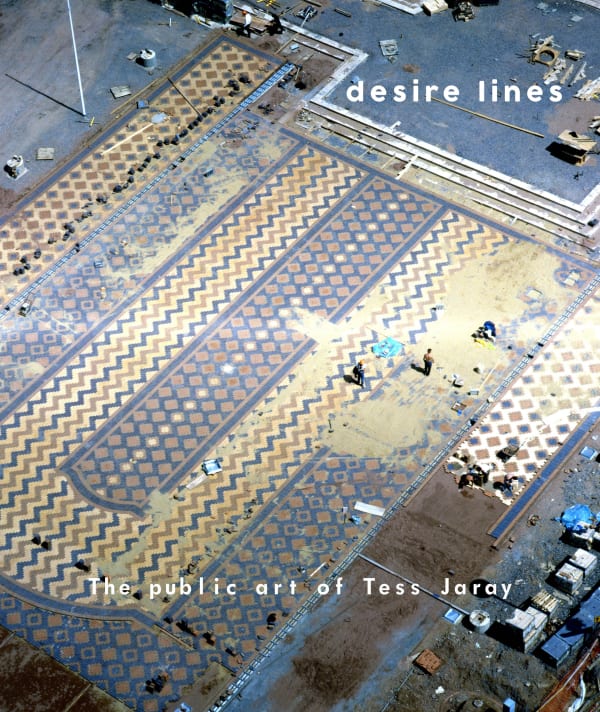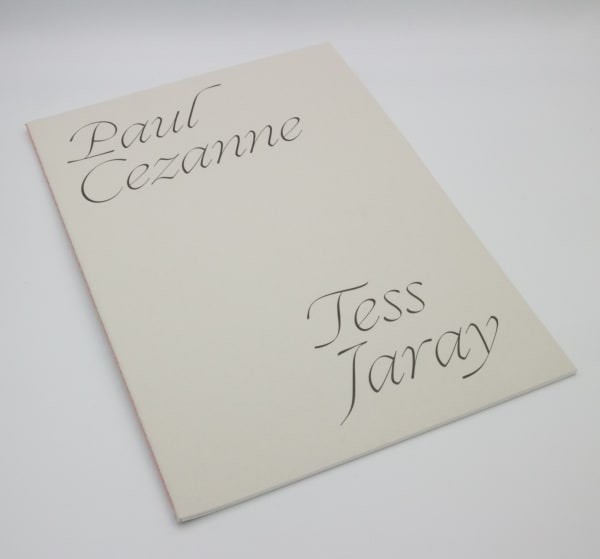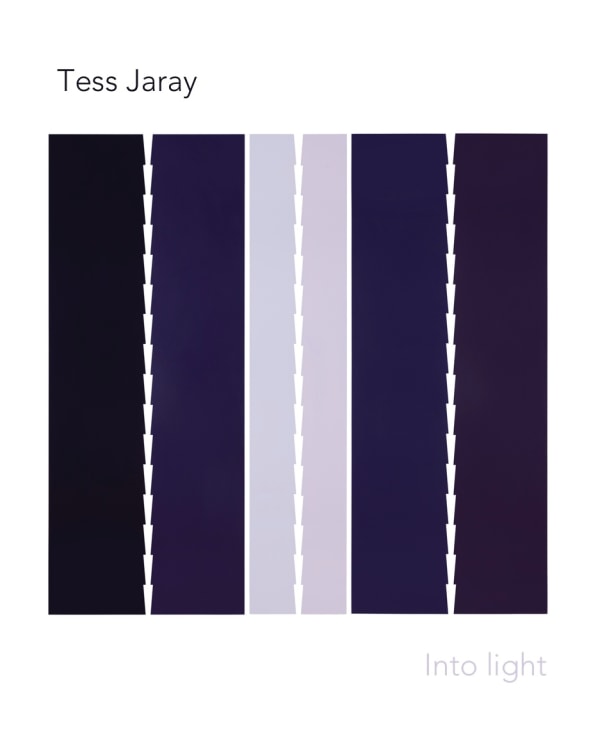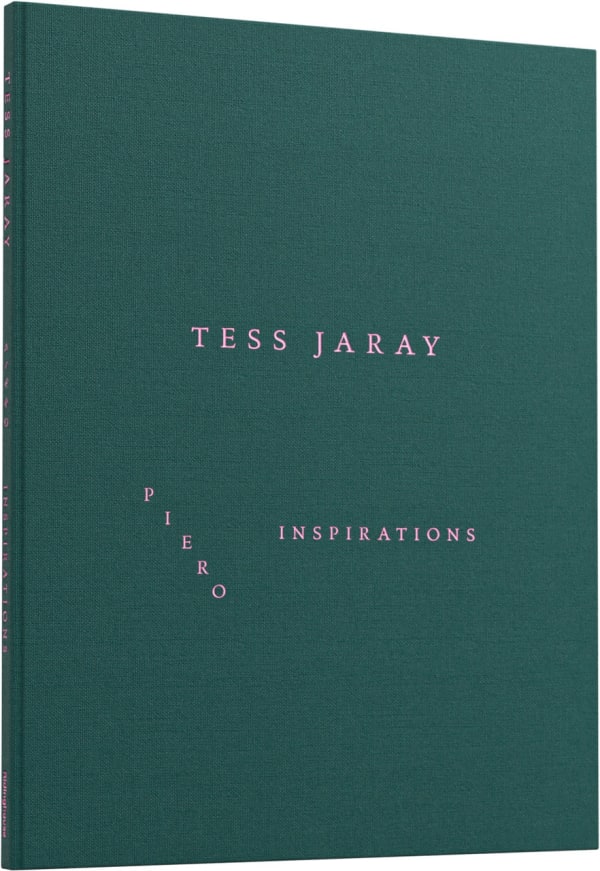Tess Jaray
Over the course of her distinguished career, Tess Jaray has developed a practice that despite sharing affiliations with minimalism, architectural drawing, Op Art and other movements, resists any singular classification.
Tess Jaray has explored the possibilities of creating space within abstract painting for more than six decades. She examines repetition, pattern and the relationship of size to scale within her surroundings, making paintings of spatial paradox in which the compositions seem to fluctuate between distance and closeness. Using line, colour and geometric forms, Jaray constructs a perception of evocative architectural spaces.
She first received critical acclaim in the early 1960s for her particular use of hard-edged painting. Critics noted how the colourful geometric constructions of the paintings were endowed with both a sober quality and expressive depth, evoking emotional responses. Jaray had created something with a controlled structure that also had an effect at a deeper level than the visual.
Tess Jaray was born in 1937 in Vienna, Austria, before coming to the United Kingdom in 1938 with her parents as part of the flight of Jewish refugees from the Nazis. The family settled in Worcestershire where Jaray grew up. She studied at Saint Martin's School of Art from 1954 to 1957 and at the Slade School of Fine Art, University College London from 1957 to 1960. In 1964 Jaray started teaching at Hornsey College of Art, working there until 1968 when she took up a role as the first female art teacher at the Slade School of Art, where she taught for three decades until 1999 when she was made Reader Emeritus.
Over the course of her distinguished career, Tess Jaray has developed a practice that despite sharing affiliations with minimalism, architectural drawing, Op Art and other movements, resists any singular classification. She has created her own pared-down visual language that focuses on the possibilities of space and how to express this through the reduction and control of form. Today Jaray continues to innovate and expand her practice from her studio in north London. She recently began to employ new geometric forms in her works.
An enduring facet in Jaray's art is the reduction of architectural form to the point of abstraction. The paintings transform architectural structures, details and surroundings into compositions that feel tangible yet distant through their use of geometry, colour, pattern, and perspective. Jaray examines with precision the deep and all-encompassing power of grand architecture and translates this experience onto a canvas, creating space, whether that be between the viewer and the artwork or within the painting itself. The viewer may perceive a three-dimensional form oscillating on the surface of the painting.
Jaray's work derives its refined aesthetic from a range of influences. The grand architecture of the Italian Renaissance and Baroque is a particular inspiration. First experiencing the art and architecture while travelling on a 'Grand Tour' of Italy in 1960, the formative experience of seeing these great works in their original setting prompted the artistic project that has engaged her for over half a century. She also finds inspiration in the formal abstraction of Islamic art and architecture, which she has gained through travels. Nonetheless, it is not only major monuments that interest the artist but also minutiae; the seemingly insignificant elements of a space that might easily be overlooked. Finding beauty in the ordinary, Jaray documents 'the detail'- the fragments of her surroundings - and subsequently reconceptualises this onto the canvas again.
Drawing is at the heart of Jaray's practice. She creates meticulous preparatory sketches and detailed drawings for all her paintings, and in doing so fills numerous sheets of paper, bringing together geometric forms and experimenting with them in patterns of varying complexity before finding one or two that would work on a larger scale. Jaray paints with flat brushstrokes, leaving a surface that to a large degree is devoid of any texture. She uses masking tape to map out her patterns on the canvas, the resulting finish is seamless. Combining colours of either tonal proximity or great contrast, she achieves a coalescence of dark and light. These colour relationships transform the compositions from simple geometric patterns to indeterminate, energetic spaces with forms that seem to be moving, suspended on the surface. The grounding colour of the painting's background further appears to control the movement of the forms.
Since the mid-1980s, Jaray has completed a succession of major art commissions in public places. The paving designs translate her patterns and ability to alter perception to a new platform, allowing people to orient themselves while treading the boundary between the feeling of stable ground and the instability of patterns. In Jaray's public commissions, her commitment to creating encompassing environments is also visible. On multiple occasions, this has involved designing not only the paving, but also railing, benches, walls and lampposts or combining the paving with paintings and prints. To this effect, she creates transitional spaces that negotiate different realms.
Tess Jaray lives and works in London.
Solo exhibitions include: Secession, Vienna, Austria (2021); New Art Centre, Salisbury, UK (2021); Barber Institute of Fine Arts, Birmingham, UK (2019); Sotheby’s S|2, London, UK (2017); Serpentine Gallery, London, UK (1988); Ashmolean Museum, Oxford, UK (1984); Adelaide Festival Centre, Australia (1980); Whitechapel Gallery, London, UK (1973).
Jaray has participated in numerous group exhibitions including: Centre Pompidou, Paris, France (2021); Barbican Art Gallery, London, UK (1993/1988); Camden Arts Centre, London, UK (1981); Hayward Gallery, London, UK (1978/selector and artist 1974); Kunsthalle, Bern, Germany (1973); Moderna Museet, Stockholm, Sweden (1965).
Her work is held in public collections including: Centre Pompidou, Paris, France; Tate, London, UK; Belvedere Museum, Vienna, Austria; Mumok, Vienna, Austria; British Museum, London, UK; Fogg Art Museum, Harvard University, MA, USA; Victoria and Albert Museum, London, UK; Western Australia Art Gallery, Perth, Australia; Whitworth Art Gallery, Manchester, UK.
Significant public art commissions include: Aleppo at King’s Cross, an installation at the Tapestry Building, London, UK (2017); Centenary Square, Birmingham, UK (1988–92); terrazzo floor in the forecourt of Victoria Station, London, UK (1986); mural for the British Pavilion at Expo 67, Montreal, Canada (1967).
In 1995 she was made Honorary Fellow of the Royal Institute of British Architects (RIBA) in recognition of these public commissions. In 2010 Jaray was elected a Royal Academician and later a Senior RA in 2013.
Biography by Viktoria Espelund
-
 Tess JarayFlower, Pink and Blue, 2022Acrylic on panel (2 panels)60 cm | 23 5/8 in diameter each panel
Tess JarayFlower, Pink and Blue, 2022Acrylic on panel (2 panels)60 cm | 23 5/8 in diameter each panel -
 Tess JarayWaiting Game, 2022Acrylic on panel (2 panels)50 cm | 19 3/4 in diameter each panel
Tess JarayWaiting Game, 2022Acrylic on panel (2 panels)50 cm | 19 3/4 in diameter each panel -
 Tess JarayChoral, 2021Acrylic on panel (9 panels)50cm | 19 3/4 in diameter each panel, (538cm | 211 3/4 in total)
Tess JarayChoral, 2021Acrylic on panel (9 panels)50cm | 19 3/4 in diameter each panel, (538cm | 211 3/4 in total) -
 Tess JaraySolitude IV, 2021Acrylic on canvas110 x 90 cm | 43 1/4 x 35 3/8 in
Tess JaraySolitude IV, 2021Acrylic on canvas110 x 90 cm | 43 1/4 x 35 3/8 in -
 Tess JaraySolitude V, 2021Acrylic on canvas110 x 91 cm | 43 1/4 x 35 7/8 in
Tess JaraySolitude V, 2021Acrylic on canvas110 x 91 cm | 43 1/4 x 35 7/8 in -
 Tess JaraySolitude VI, 2021Acrylic on canvas105 x 91 cm | 41 3/8 x 35 7/8 in
Tess JaraySolitude VI, 2021Acrylic on canvas105 x 91 cm | 41 3/8 x 35 7/8 in
-

Tess Jaray
For Your Eyes Only 15 Mar - 15 Apr 2023 Karsten Schubert LondonKarsten Schubert London presents an exhibition of new roundel paintings by Tess Jaray.Read more -

Tess Jaray
New Paintings 17 Feb - 1 Apr 2022 Karsten Schubert LondonKarsten Schubert London's first exhibition of 2022 is dedicated to new paintings by Tess Jaray.Read more -

Tess Jaray: The Serpentine Paintings
Artissima 2021, Turin 5 - 7 Nov 2021This solo booth is dedicated to works from Tess Jaray's landmark 1988 exhibition at the Serpentine Gallery.Read more -

FIAC Online Viewing Room
Tess Jaray, Alison Wilding, Cathie Pilkington 21 - 25 Oct 2021 OnlineWe are pleased to participate in the 2021 FIAC Online Viewing Rooms with a focused look at new and recent work by Tess Jaray, Cathie Pilkington and Alison Wilding. These...Read more
-

Podcast: A brush with... Tess Jaray
Interview with Ben Luke for The Art Newspaper February 1, 2023Tess Jaray speaks with journalist Ben Luke for his podcast 'A brush with...' This in-depth interview with Jaray touches on her cultural experiences and greatest influences, from Henri Matisse to W.G. Sebald.Read more -

Tess Jaray in the Gwangju Biennale
South Korea, April 2023 September 22, 2022Tess Jaray will participate in the 2023 Gwangju Biennale, South Korea's foremost contemporary art biennial.Read more -

Tess Jaray and Rana Begum in Conversation
Friday 1 April, 10:30–11:30am March 28, 2022Join us Friday 1 April for a breakfast in-conversation with Tess Jaray and Rana Begum.Read more -

Tess Jaray: Whitechapel Gallery Art Icon Charity Auction
16 – 23 March 2022 March 18, 2022Tess Jaray's painting Solomon and the Queen of Sheba III (2019) is part of Whitechapel Gallery's Art Icon Charity Auction with all proceeds benefitting Whitechapel Gallery's Education Programmes.Read more
-

Desire Lines
The Public Art of Tess Jaray Preface by Vivien Lovell, text by Charles Darwent, interview with the artist by Doro Globus, 2016Softback, 96 pp, 67 colour ill. pagesRead more
Publisher: Ridinghouse 2016
Dimensions: 23 × 19.5 cm | 9 1/8 × 7 5/8 in -

Paul Cezanne: Drawings
Tess Jaray: Roundels 2020Softcover, 23pp pagesRead more
Dimensions: 25 x 17 cm -

Tess Jaray
Into Light 2017Softback, 50pp pagesRead more
Publisher: Marlborough Fine Art | Ridinghouse
ISBN: English
Dimensions: 29.7cm x 23.8 cm -

Tess Jaray
Piero Inspirations Preface by Tess Jaray. Extracts by Roberto Longhi, 2021HB, 48pp pagesRead more
Publisher: Ridinghouse
Dimensions: 31 x 24 cm
















